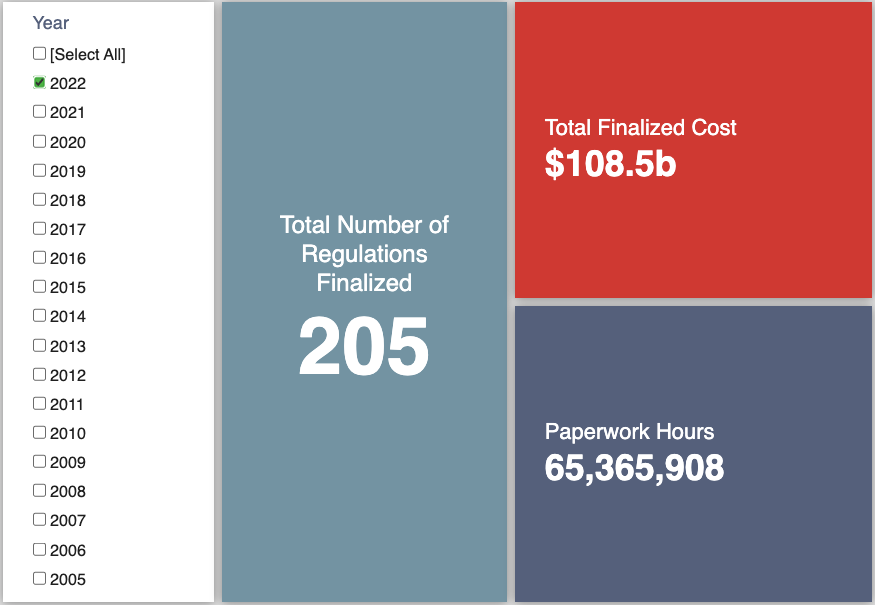Week in Regulation
November 7, 2022
EPA’s HFC Proposal Tops Billion-dollar Week
November arrived with 10 rules with an estimated economic impact published in the Federal Register. Included in the bunch was a costly proposal from the Environmental Protection Agency (EPA) regarding hydrofluorocarbons (HFCs) and a final rule from the Department of Health and Human Services (HHS) that added millions of hours in annual paperwork burden. Across all rulemakings, agencies published $1.1 billion in total costs and added 3.5 million annual paperwork burden hours.
REGULATORY TOPLINES
- Proposed Rules: 37
- Final Rules: 56
- 2022 Total Pages: 66,822
- 2022 Final Rule Costs: $108.5 billion
- 2022 Proposed Rule Costs: $125.4 billion
NOTABLE REGULATORY ACTIONS
The largest rule published this week in terms of economic impact was EPA’s anticipated proposal regarding the “Phasedown of Hydrofluorocarbons: Allowance Allocation Methodology for 2024 and Later Years.” HFCs are chemicals that replaced ozone-depleting substances but have global warming potential that EPA says can be “hundreds of thousands of times” greater than carbon dioxide. A 2020 law, the American Innovation and Manufacturing Act, directed EPA to deal with HFCs, and included setting regulations for phasing down their production. The rule comes with an estimated present value cost of $740 million (at a 7 percent discount rate), while – according to EPA – offering just $125 million in climate benefits.
HHS published this week’s costliest final rule, an annual Medicare update to payment rates and other program standards for home health agencies (HHAs). The rule for 2023 includes total estimated costs of $276.1 million to HHAs for submitting required information and an annual paperwork burden of 3.4 million hours.
TRACKING THE ADMINISTRATIONS
As we have already seen from executive orders and memos, the Biden Administration will surely provide plenty of contrasts with the Trump Administration on the regulatory front. And while there is a general expectation that the current administration will seek to broadly restore Obama-esque regulatory actions, there will also be areas where it charts its own course. Since the AAF RegRodeo data extend back to 2005, it is possible to provide weekly updates on how the top-level trends of President Biden’s regulatory record track with those of his two most recent predecessors. The following table provides the cumulative totals of final rules containing some quantified economic impact from each administration through this point in their respective terms.
This week’s HHS final rule resulted in the Biden Administration claiming the most new total costs added compared to the same week in the Trump and Obama Administrations. The Obama Administration added $143 million in costs this week back in 2010 through a Department of Education rule that added numerous “program integrity” requirements. That rule contained more than 6 million hours in added annual paperwork. For its part, the Trump Administration reduced costs by about $6 million, primarily through a defense contracting rule.
THIS WEEK’S REGULATORY PICTURE
This week, the Department of Justice (DOJ) revises its regulation for dealing with journalists publishing classified information.
On November 3, DOJ published a final rule in the Federal Register pertaining to how it obtains information and records from journalists and questions, arrests, or charges members of the news media.
The rule implements a policy announced in a July 2021 memorandum issued by Attorney General Merrick Garland that prohibits the use of compulsory legal processes, such as search warrants, subpoenas, and court orders, against newsgathering media that publish classified information. The memo also tasked DOJ with reviewing its existing regulations dealing with journalists and classified information. The new regulations codify DOJ’s policy, giving it more legal weight than a simple memorandum.
The rule prohibits the use of compulsory legal processes against reporters and their media organizations, with some exceptions. Those exceptions include authenticating information that has already been published, obtaining information when a journalist is a suspect or target of an investigation for committing a crime, or when “necessary to prevent an imminent or concrete risk of death or serious bodily harm, including terrorist acts, kidnappings, specified offenses against a minor, …or incapacitation or destruction of critical infrastructure.” Obtaining information under one of these exceptions will require the approval of the deputy attorney general.
The rule is an interpretive rule, meaning that it pertains to DOJ’s internal procedures and how it interprets the law. As such, it was not required to be made available for public notice and comment prior to being finalized under the Administrative Procedure Act. It went into effect the day it was published.
TOTAL BURDENS
Since January 1, the federal government has published $233.8 billion in total net costs (with $108.5 billion in new costs from finalized rules) and 140.7 million hours of net annual paperwork burden increases (with 65.4 million hours in increases from final rules).












